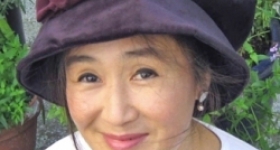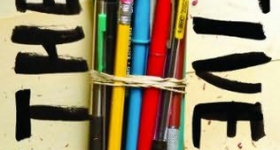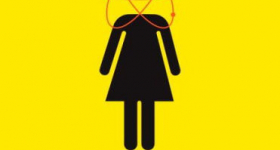The Asian American literary community has got to bring its sexy back. The sad truth is that there is not much Asian American erotic literature published in the mainstream. The only established work of erotic lit by Asian Americans in existence is On a Bed of Rice, an anthology of fiction and poetry edited by Geraldine Kudaka and published in 1995 — pre-Facebook, pre-sexting and even pre-Sex and the City.
One theory to explain the dearth of Asian American erotic writing points to the great risk involved, at least when Asians first arrived in America. In the foreword to On a Bed of Rice, writer Russell Leong observes that important books like the Asian American Studies 101 primer Strangers from a Different Shore by Ronald Takaki neglect to explore Asian American eroticism, likely because of silences imposed by exclusion acts and anti-miscegenation laws during the early waves of Asian immigration. How, indeed, could early immigrant writers (mostly men who were not allowed to bring spouses or were legally prevented from dating other races) speak about their sexual experiences (racy, forbidden intercultural experiences with white, black, Latina or Native American lovers at that) when in danger of severe punishment? Another theory is that in many Asian cultures, sex is simply not discussed openly and freely.
Not all hope is lost. Up-and-coming young writers have been furiously making up for lost time. One exciting writer of erotic literature is Teresa Lo, author of the series The Red Lantern Scandals about 20-something Angelenos on the cusp of sexual awakening. The book is not just about sex but about discovering and celebrating one’s independence.
Teresa and I sat down over apple martinis and had a long, delicious chat about what makes for quality sexy reading. We came up with the following guidelines in the hopes that you, dear reader, will seize the opportunity — nay, heed the obligation — to take up some erotic writing yourself and spread the sexual healing among your largely repressed kin.
Lose the hang-ups. As Asian Americans, we have a lot of them. Unfortunately, it’s not just about shedding inhibitions or ignoring what our mothers will think. As already mentioned, the lack of an Asian American erotic writing tradition has a lot to do with historical and legislative encumbrances placed upon our ability to express freely. Celebrate our historical and social leaps and bounds — express yourself freely! If you really can’t ignore what your mother will think, then write under a pen name. Most importantly, DO NOT JUDGE en route to shedding your inhibitions. Period. Don’t judge yourself, your readers, your characters or anyone else. Just develop the characters and go with the actions that unfold naturally.
Don’t go there. By “there,” we mean geishas, weird anime fantasies, china dolls or whatever popularized Orientalist conceptions that have made Asian Americans “objects, rather than the subjects” of sexual exploration, to quote Russell Leong. Let go of the fetishes and played-out stereotypes. Haven’t we had enough of soldier-prostitute tales, war bride tragedies, Asian men who prey on white women and dragon ladies? Much sex-scene writing out there is dreadful enough — hence the existence of the Bad Sex in Fiction award given by The Literary Review. So dare to be brave — cast stereotypes aside and plow virgin literary soil.
Get in the mood. The proper mood must be set for the mental foreplay to begin. Play sexy music (D’Angelo would be my recommendation) and wear lingerie. Heck, why not go all the way and write naked (naked = vulnerable, vulnerable = higher stakes, higher stakes = charged writing). At the very least, light a scented candle. Or, and a few writer friends have seriously sworn by this, try to stop having sex for days or weeks before writing the sex scene in order to transmit your own pent-up horniness onto the page.
Know your characters. “When I write, I get into my characters’ heads, and I let their personalities dictate what they will do and how the scene will play out,” Lo says. Before writing a sex scene, you must fully develop the characters. So do an interview in your head with your characters. What are their beliefs and motivations? What makes them vulnerable? What internal and external conflicts are they undergoing? There must be something at risk so that the sex scene reveals a new side to the character. Ultimately, your reader must be able to immerse themselves in the characters and feel how they are feeling so that the sex has emotional weight.
Set the scene. Unless you’re writing about paranormal characters, the logic must be believable, so be aware of spatial or temporal limitations. For example, having sex outdoors in the snow during an earthquake is not very believable no matter how taken by the moment — or flexible — your characters are. As a rule of thumb, try something new. Usually, the more common the setting, the less interesting the scene. Other places to avoid include elevators, airplane toilets, car backseats, office desks and hot-air balloon rides. More importantly — details, please! Guide readers in using their imaginations by being as suggestive as possible. How to do this? Easy — just engage all the senses. How do things smell, feel, taste and sound as the characters progress to the moment of truth?
Have a plot. You must build anticipation and intensity. Don’t just fast-forward to the humping like in your younger brother’s cheap porn flicks. The sex scene should have a purpose in advancing the story or relationship between the characters. In romance novels, there is usually conflict between the characters that turns into attraction and culminates in the act, which then reveals hidden truths or previous misguided beliefs. The best orgasms involve emotions — not just “ooohhh baby” and “give it to me” accompanied by some spanking and lip-locking.
We said erotic, not pornographic. As Lo puts it, “sexual tension needs to be built for a sex scene to actually be sexy. Otherwise, they’re just sentences about penises and vaginas. Something erotic, on the other hand, is supposed to be sensual. The journey that gets you to your climax is just as important as the climax itself. That’s why most books that have graphic sex can never be ‘pornographic’ because writing is supposed to have developed characters and plots.” To create tension, you must tantalize and provoke the reader. Linger on foreplay. Be subtle. Allude rather than be graphic. Focus on body parts that are largely ignored: the small of her back, the base of his neck, the luminous scars acquired after a bout of adolescent chickenpox and so on. Don’t make up new sex positions as though you’re trying to rival the Kama Sutra. Be romantic and sensual. Don’t overdo anything. And try to leave biting or scratching out.
Watch your language. Avoid clichés like sexually transmitted diseases. Clichés make scenes laughable. Don’t say “she saw fireworks” or “felt waves of ecstasy.” Nothing should be described as “hot and heavy.” Furthermore, don’t dwell on bodily fluids or anatomy. Clinical or mechanical descriptions are not sexy. Avoid using euphemisms for genitalia. And for God’s sake, do not mention love rocket, cock, maidenhead or beaver. Rather, show. Don’t tell. Use strong verbs. Be suggestive rather than overly descriptive. Do this by using metaphors, similes and imagery. Finally, don’t be redundant — readers’ eyes will roll if you use “throbbing” more than once.
Rewrite and rewrite! As with any writing, you must edit, rewrite, edit and rewrite again. In the end, the scene should turn you on when you read it. You should not be laughing at what you wrote (unless you were intentionally trying to be funny).
Keep improving by learning from others. “Having a lot of sex, unfortunately, will not make you a great erotica writer,” Lo says. “But reading a lot of romance or erotic literature and seeing what’s sexy or not will give you the best idea of how it’s done.” Lo recommends that aspiring erotica authors check out the e-books section on Amazon rather than look for hardcovers. “A lot of writers self-publish dirty stories, and most are actually pretty good,” Lo says. “The best way to find them is to read the samples or download a free promotional copy.”
And there you have it. We urge you to put these tips into practice. As further incentive to serve our literary community, Hyphen is holding an erotic sex-scene writing contest. For details, please go to hyphenmagazine.com.
Abigail Licad is a books editor at Hyphen. She last wrote about authors who self-publish.
Read more from Issue 27: The Sex Issue, available now. Subscribe to Hyphen or pick up a copy at a newsstand near you.










Comments